
MMA Classification loose-leaf binder with handwritten notes, circa 2001. All photos by the author
One of my earliest memories from when I started working at Watson Library as a cataloger almost twenty years ago was being handed a huge set of binders and being told, "These are yours!" They were my copy of The Metropolitan Museum of Art (MMA) classification schedule and each cataloger had their very own set which had to be updated by hand whenever a new call number was added. The MMA classification schedule was based on the Dewey Decimal Classification system—a system of call numbers that arrange books by subject matter on the shelves—and the Cutter tables. I was more familiar with the Library of Congress (LC) classification schedule used in most college libraries and was inwardly appalled at the thought of using what I considered an outmoded system. My disappointment would not last for long.

MMA Classification loose-leaf binders, circa 1988 and 2001
The early Metropolitan Museum of Art library staff were rightly proud of this classification system: it was created in the early twentieth century and geared towards the arrangement of art books with the browsing of curatorial staff in mind. The first guidelines were published in 1911—Classification Systems Used in the Library: Photograph Classification, by Ethel A. Pennell, and Book Classification, by Lucie E. Wallace—and other museum libraries would adopt its use (although just as many created their own systems). As The Met's library collections grew, so too did the MMA classification schedule. When I arrived in the year 2000, Watson Library had a twenty-thousand volume backlog of uncatalogued books. As the staff considered ways we could speed up the cataloging, one way considered was to switch to the LC classification system—a step which would allow catalogers to import bibliographic records from RLIN (a cataloging utility) without having to create a new call number for every single book, since many records on RLIN already included an LC call number. RLIN later merged with OCLC (see below) in 2006, and bibliographic records now come from OCLC.
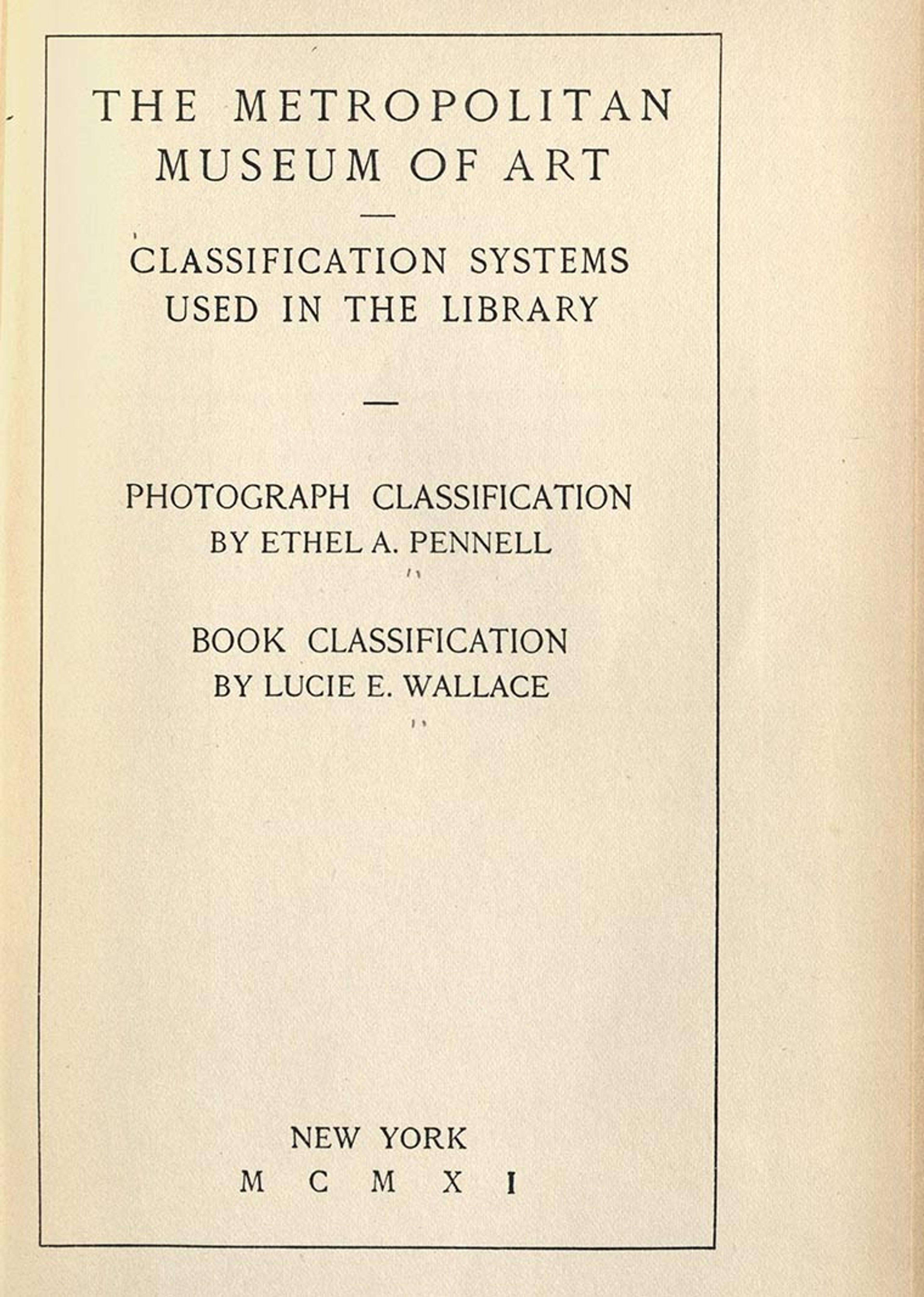
Classification Systems Used in the Library: Photograph Classification, by Ethel A. Pennell, and Book Classification, by Lucie E. Wallace (New York: The Gilliss Press, 1911). First publication of the MMA's classification system for arranging books by call number
One of the major initiators of change in the library during this time was the former associate chief librarian (now retired), Daniel Starr, who was hired in 2001 as the manager of bibliographic operations. Daniel noted immediately the problems with the MMA classification. So in 2002, the use of LC call numbers was implemented by the library, under Daniel's encouragement, for all newly cataloged books—the cataloging staff were trained and decisions made as to exceptions, such as for some departmental books. This first step in standardization allowed patrons to have quicker access to many titles, and it was one of the changes in procedures which led to a rapid reduction of our backlog.
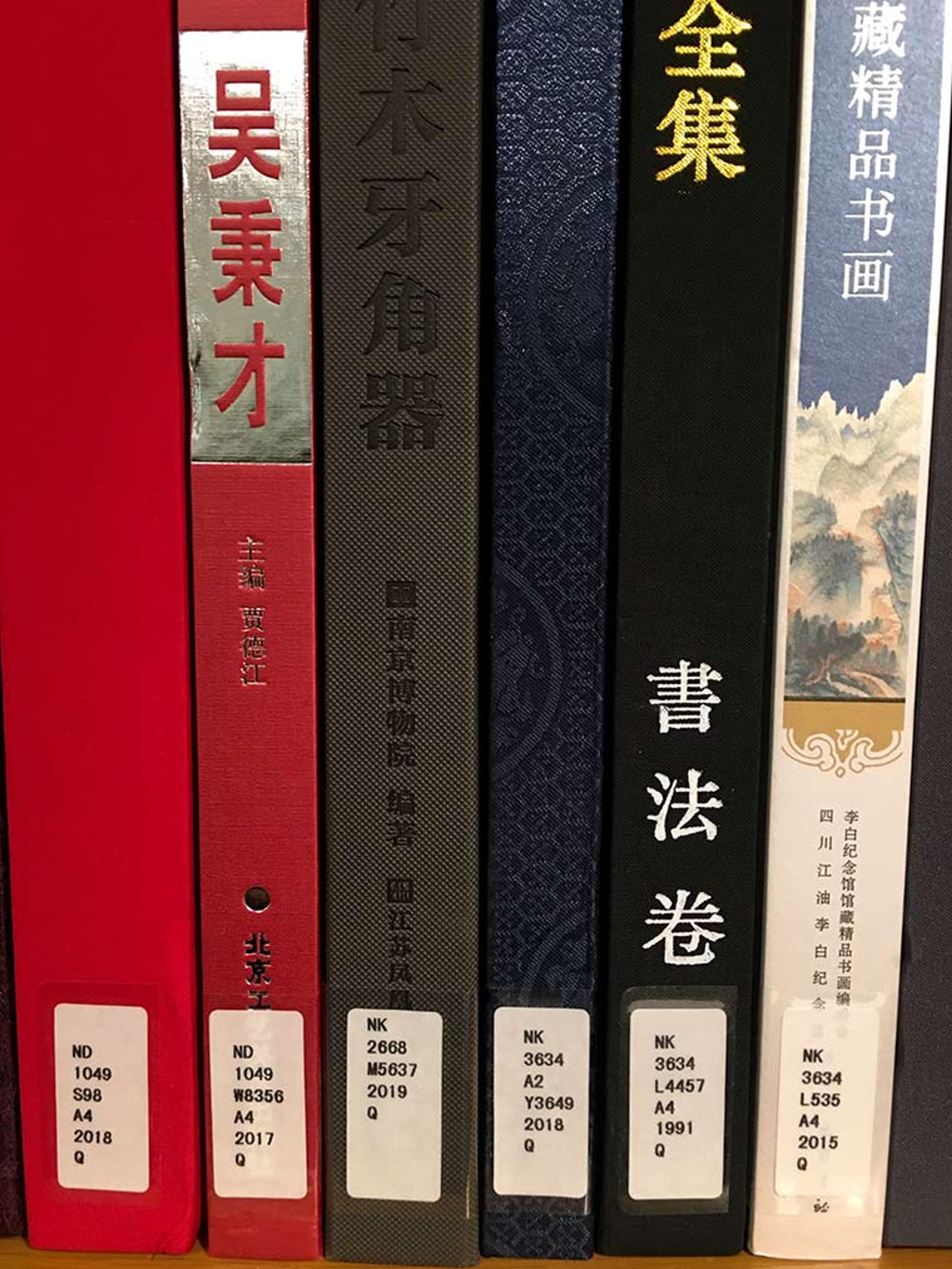
Examples of book labels with Library of Congress call numbers on the spines of recently cataloged books at Watson Library
Over the years there have been several changes in our work practices and in the world of cataloging that have led Watson Library to move ever further down the path of standardization: in June 2005, several staff members were trained in Name Authority Cooperative Program (NACO) authority work during a five-day class taught by Art NACO liaison, Sherman Clarke (then head of original cataloging at NYU Libraries). Authority work is the practice of creating one authorized form of a name, which is then used consistently in library catalogs worldwide, thereby collocating all books written or associated with that person together in a single search. NACO is a program that allows institutions to add name authority records to LC's name authority file: a large file which libraries all over the world have access to through OCLC (a global library union catalog - you may know it better as WorldCat.org, its public interface). Watson Library is an active participant in NACO to this day and that means we are helping people worldwide in finding the materials they need when searching by name.

A personal name authority record added to the Library of Congress Name Authority File by Thomas J. Watson Library as a member of NACO (Name Authority Cooperative Program). "NNMM" is the code or symbol used to identify the Watson Library in records that we have created for NACO and can be seen in the 040 field.
A radical change came in 2012 and 2013 when the Library of Congress implemented the use of a shiny new cataloging standard known as Resource Description and Access (RDA). For decades (from 1967 to 2012), libraries across the world used a cataloging standard known as the Anglo-American Cataloguing Rules (AACR), whose precisely numbered rules guided librarians in how to describe library materials (books, serials, audiovisual items, etc.). But those rules were created when library records were still housed in card catalogs: vast bays of drawers filled with index-sized cards which held the descriptions of books (often tediously typed up on a typewriter). With the advent of the internet in the 1990s, librarians realized that the card catalog mindset embodied in AACR was antiquated in a modern world where things could be hyperlinked and an infinite number of relationships drawn out between library data. RDA was seen as the first step in re-conceptualizing the world of describing library data.

Michael Gorman and Paul W. Winkler, Anglo-American Cataloguing Rules (Chicago: American Library Association, 1988). Now outdated cataloging rules formerly used by Watson Library
It's no surprise then that Watson Library was eager to embrace the new guidelines. Andrea Puccio (now Collections Management Librarian at the ClarkArt Institute) and I were appointed as RDA trainers, and we set up six training sessions for the cataloging staff from January to March 2013. Our training sessions were based on materials put out by the Library of Congress. We have been utilizing RDA ever since. As a patron, you likely won't be able to tell the difference between an RDA and an AACR record, but one difference is that there are almost no abbreviations in RDA description—they are not allowed in the RDA guidelines (e.g. "p." is always written as "pages" in RDA).

Joint Steering Committee for development of RDA, RDA: Resource Description & Access (Chicago: American Library Association, 2012). The loose-leaf print version of the current cataloging standard used by Thomas J. Watson Library. Its advertising flyers described it as "designed for the digital world and an expanding universe of metadata users." It is already nearing obsolescence.
The most recent move towards standardization for the Watson Library is our acceptance into the BIBCO program managed by the PCC (Program for Cooperative Cataloging, in turn, run by LC) in 2018. BIBCO is the Monographic Bibliographic Record Cooperative Program, and its members (libraries across the country) agree to create at least one hundred bibliographic records a year that adhere to the very strict BIBCO Standard Record guidelines. These guidelines are based on RDA and require that the inputting library also create every authority record needed for name and subject headings in the bibliographic record. William Blueher (Metadata & Collections Librarian) and I were trained as the library's BIBCO catalogers starting in November 2018, with our review period ending in May 2019. In addition, this year William and I are giving review training to the cataloging staff in regular NACO practices and Luxuan Liu (Assistant Museum Librarian, Chinese/Japanese/Korean [CJK] cataloger) will be our first official CJK NACO trained staff.
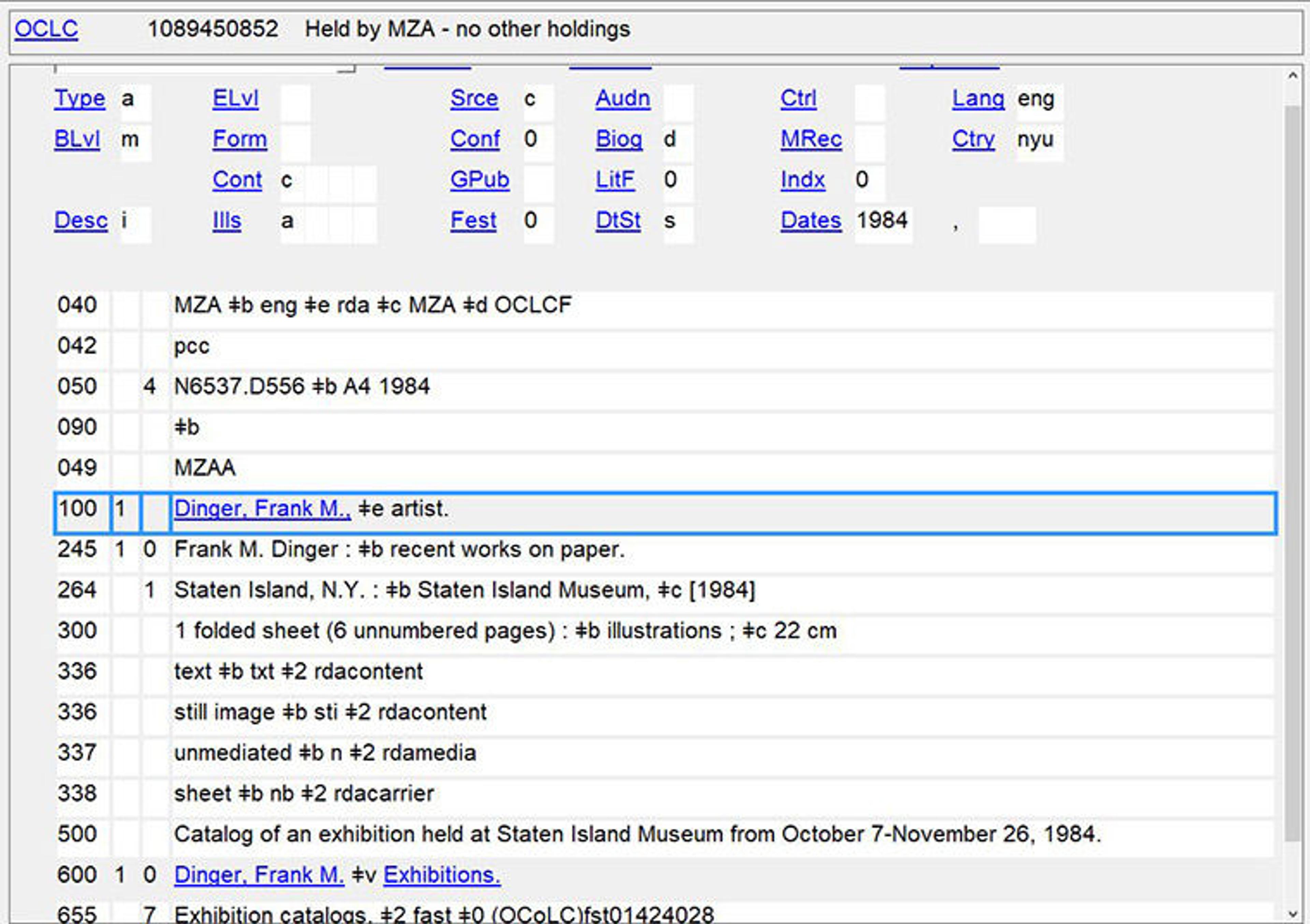
A PCC record created by the Thomas J. Watson Library. Our OCLC symbol is "MZA" and can be seen in the 040 field. You can tell this is a PCC records by looking at the 042 field.
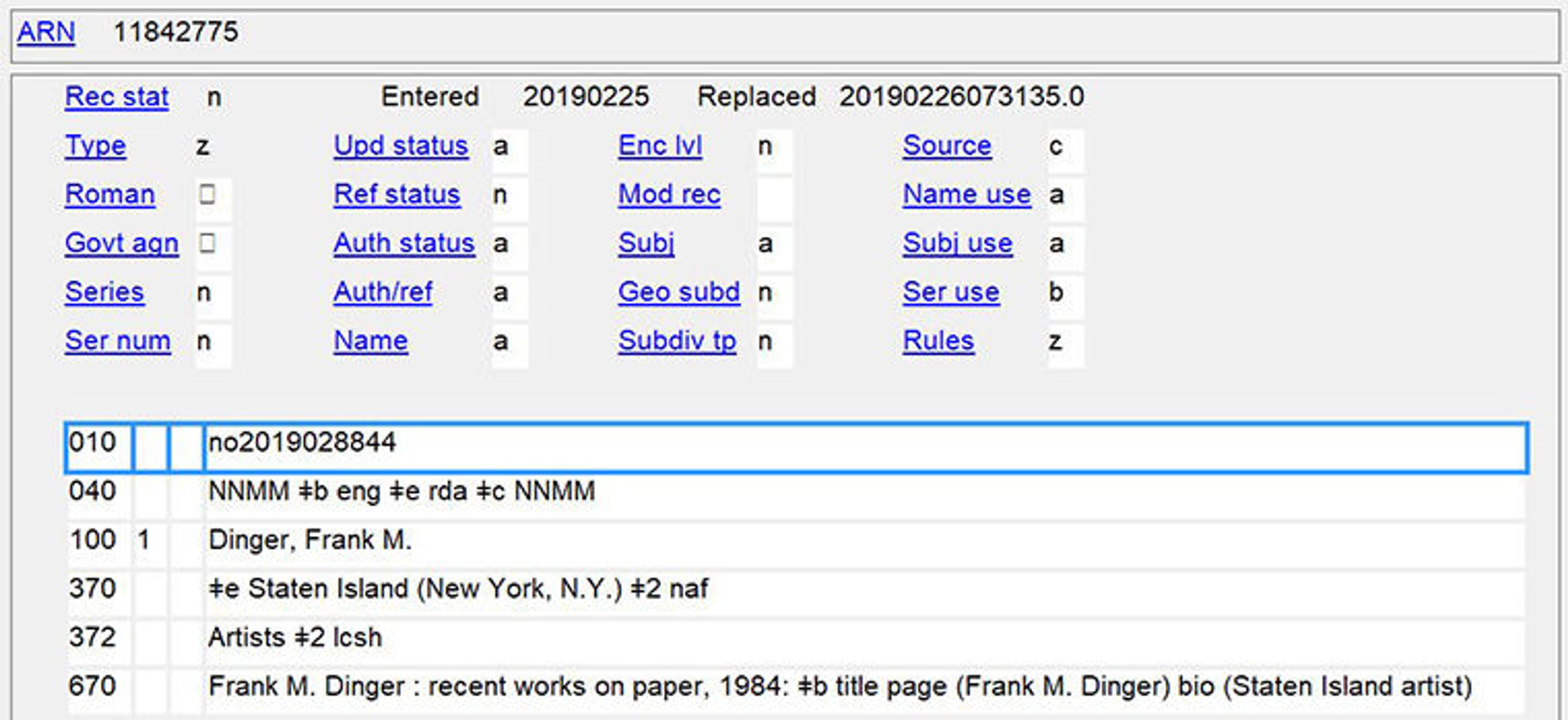
A personal name heading created by us and based on the above bibliographic record
Participation in these cooperative programs allows Watson Library staff to not just enhance our own cataloging skills and records, but more importantly, to add our voices and expertise as art museum librarians to a larger library cataloging community. We are no longer creating a classification system kept in binders just for ourselves.
What is in the future for library and cataloging standards? Lots of exciting potentialities! There is a new conceptual reference model (a way of viewing how to organize and describe things, in brief) known as the IFLA Library Reference Model (LRM) which was published in 2017. What is important about this model is that it was designed to support and promote the use of bibliographic data in a linked data environment.
LRM takes into account the best practices that allow data to be shared, such as adding URIs to headings in bibliographic records. The RDA guidelines to cataloging are now being revamped as part of the RDA Toolkit Restructure and Redesign (3R) Project, which is editing the RDA content in order to bring it in compliance with LRM. While the 3R Project is not yet complete, Watson Library has already started adding URIs to the headings in our records. You won't see the URIs in the public view, but they are there—take a look at this record (Alicja Kwade: ParaPivot) and click on MARC display. You can see the URIs lurking in the 700 fields at the bottom of the record—they all start with "http." This is just a small step forward in an effort to massage our data so it can be searched more easily.
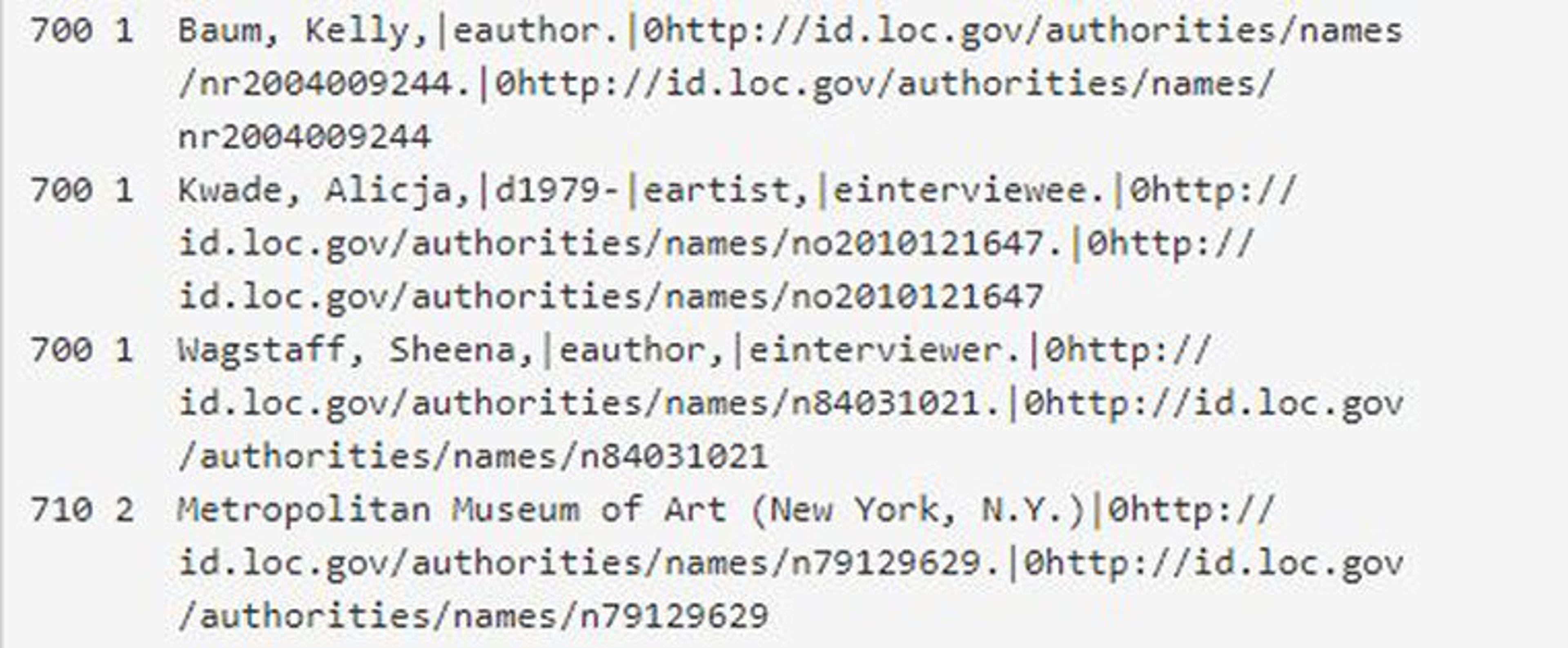
URIs in a Watson Library bibliographic record—URIs are used in a linked data environment to link our data with another institution's data which makes it easier to search for things on the web.
As Watson Library continues to adapt and change our practices, library patrons will find the materials they need much more readily. We have come a long way from utilizing practices that were unique to us (e.g. the MMA call numbers) to being active participants in cooperative cataloging programs and following the evolving descriptive cataloging standards. It is an exciting time to be a cataloger, and we hope that in the end, all these changes will help us serve our library patrons better than ever.
